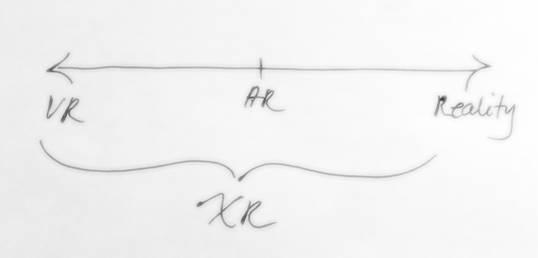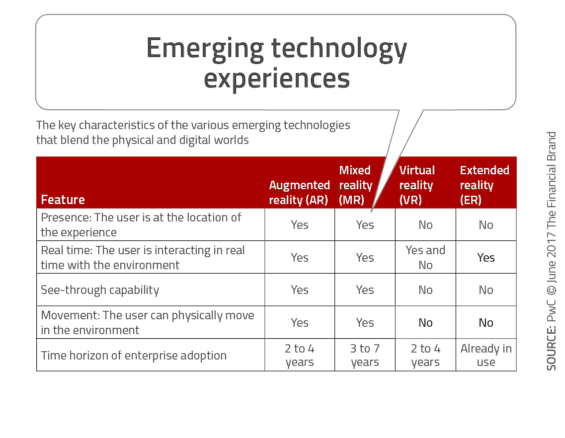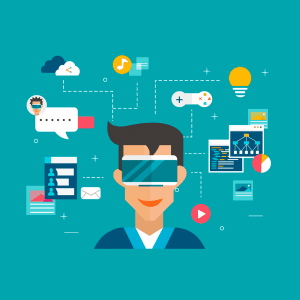Most sci-fi movies have planted the seed in our head that we will be able to tele-transport ourselves instantly, like in the movie “Jumper,” where the main character is able to “jump” from one part of the world to another with a snap of his fingers.
Maybe that possibility is a little too far into the future for the metaphysicists and scientists of our generation. However, cutting-edge technology brings us the opportunity to do something similar. We are talking about extended reality (XR).
What Is XR?
XR is described as the combination of real world, virtual world, and human-machine interaction. Meaning, it is a superset of the range of virtual possibilities––augmented reality (AR), virtual reality (VR), mixed reality (MR), and 360-degree videos––combined with the real world.
AR is the insertion of augmented, computer-generated elements into the real world, for example, when you take a picture of yourself using Snapchat with the Dog Filter.
On the other hand, VR is just the opposite. Getting immersed in the digital world with tools like Google or Samsung glasses. A great example is when you are playing video games using PlayStation glasses and, with the help of external gadgets, you feel completely surrounded by the digital world, and you become a cook, bartender, etc.
The degree of digital immersion that you have in the real world describes the reality you are in. As we see in the picture below, the further to the right you go, the greater the digitalization of your reality.
It is a new way of considering quantum reality.

Soon, we will be able to walk around cities without even noticing or distinguishing between real or generated images.
It can be confusing to keep track of all the immersive technologies that are currently out there and that help us to connect with people, receive information, and perceive unforgettable experiences.
XR is the new generation of cutting-edge technology that blends our real world with the digital and virtual one.
The trend in quality is going to start being less concerned about the “where,” or the place you experienced, and more focused on the “how,” or what technology made it possible.
Nearly 80 percent of executives believe that extended reality tools can be a great asset to develop relationships with customers and employees.
However, a large number of managers and team leaders do not realize the actual capacity that new technology has on achieving goals, not only from outside your organization but also inside. Using XR technology allows you to close the gap between your workers and the culture of your organization, putting your company's name in the customer's mind first.
For instance, with your workers, you can organize activities aiming to train them using XR. Employees can improve their skills with a simple and enjoyable digital game that doesn’t require the company to spend a lot of resources or materials on. There are also plenty of day-to-day activities that you can keep track of in a smoother way, such as completing a checklist of new inventory. It looks more fun being able to do it using your digital and connected helmet than going around boxes searching for the item itself. Take the example of the TwoReality project called Daqri Smart Helmet, which facilitates the manufacturing work by many hours of searching or checking machines.
Likewise, customer satisfaction and customer care are two areas that you can tackle easily with the help of this new generation of realities. Imagine how impressed your client will be if you show them the final product or service in situ with the help of this immersive technology. There have been many restaurants where they started to implement this technology. Based on a digital and virtual menu, the guest can foresee how the dish will look and see what appetizes them the more. That will stick in their minds and make them pick you before any other of your competitors.
Even though it looks easy, it has not been that way at all. This is a transition that companies have been integrating into their strategy in a very slow way. Some of them did trust this technology from the beginning, others did not have the resources to implement it, and others wanted to see the reaction from the customers before they go “all-in” with it.
Stages of the X-Generation
Usually, companies start adopting VR strategies in the early stages of their digital strategies. The difficulty lies in creating better and new experiences for the customers, meaning that companies are usually pushing themselves to adopt more mature solutions and tools that work across the spectrum.

There is only one aspect that the industry has yet to improve, and that is giving the user total freedom of movement within VR. Currently, there is this “freedom” within a closed environment. Users can only receive a specific VR experience if they do not leave a determined area. In the future, we will be able to move around cities, countries … or even planets! And still continue operating within the digital world.
The edges and limits will be set by the company that develops that product.
With AR, users can bring along that sense of immersion in the digital scenario. AR is implemented in the real world without the need for goggles or extra computers. Like the app game “Pokémon Go,” where you can see and capture Pokémon around your city through the lense of your smartphone.
Below, we’ve made a list of startups working toward shaping the future with AR technology.
Augmented Reality Startups
HoloLamp creates 3D optical illusions, allowing you to carry around your AR experiences without needing special glasses. It works by bringing you portable devices that users can activate in all kinds of different environments.
They have developed an amazing restaurant tool that allows clients to have one of the most unforgettable experiences: seeing their food before they even order it.
Travel AR sets the entire world in front of you, using your phone. Moving around the e-sphere, you are able to check all the different countries of the world, select one, and see hand-picked videos and highlights of each location. Deciding where to go on your next vacation and what you can expect just became a whole lot easier.

Extended reality has shown how powerful an asset it can be for companies to improve their customer experiences and overall thoughts of a possible customer when they think about your company not only for your business but also for your inner organization. It can create amazing experiences that customers won't be able to erase from their mind or interactive resources by which you bring value to your business culture.
A new funnel of conversation has been born between companies or brands and end-consumers, where the use of extended realities can bring more efficiency and overall profitability into the market.
VR, AR, the combination of both (MR), or even 360-degree videos will allow us in the future to interact with the digital world without noticing that it has blended over into our own world.
